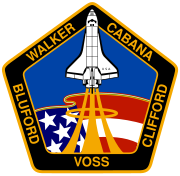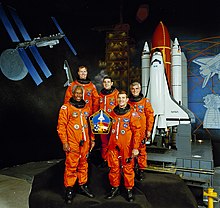STS-53
 Launch of Discovery for a Department of Defense (DoD) mission | |
| Names | Space Transportation System-53 |
|---|---|
| Mission type | DoD satellite deployment |
| Operator | NASA |
| COSPAR ID | 1992-086A |
| SATCAT no. | 22259 |
| Mission duration | 7 days, 7 hours, 19 minutes, 17 seconds |
| Distance travelled | 4,883,840 km (3,034,680 mi) |
| Orbits completed | 116 |
| Spacecraft properties | |
| Spacecraft | Space Shuttle Discovery |
| Launch mass | 110,655 kg (243,953 lb) |
| Landing mass | 87,565 kg (193,048 lb) |
| Payload mass | 11,860 kg (26,150 lb) |
| Crew | |
| Crew size | 5 |
| Members | |
| Start of mission | |
| Launch date | December 2, 1992, 13:24:00 UTC (8:24 am EST) |
| Launch site | Kennedy, LC-39A |
| Contractor | Rockwell International |
| End of mission | |
| Landing date | December 9, 1992, 20:43:17 UTC (12:43:47 am PST) |
| Landing site | Edwards, Runway 22 |
| Orbital parameters | |
| Reference system | Geocentric orbit |
| Regime | Low Earth orbit |
| Perigee altitude | 365 km (227 mi) |
| Apogee altitude | 376 km (234 mi) |
| Inclination | 57.00° |
| Period | 92.00 minutes |
| Instruments | |
| |
 STS-53 mission patch  Back: Walker, Cabana and Clifford Front: Bluford and Voss | |
STS-53 was a NASA Space Shuttle Discovery mission in support of the United States Department of Defense (DoD). It was Discovery's 15th flight. The mission was launched on December 2, 1992, from Kennedy Space Center, Florida. This was also the last mission to have been operated via MCR-2 in JSC. Afterwards the room was restored entirely to its Apollo era appearance.
Crew
[edit]| Position | Astronaut | |
|---|---|---|
| Commander | David M. Walker Third spaceflight | |
| Pilot | Robert D. Cabana Second spaceflight | |
| Mission Specialist 1 | Guion Bluford Fourth and last spaceflight | |
| Mission Specialist 2 Flight Engineer |
James S. Voss Second spaceflight | |
| Mission Specialist 3 | Michael R. Clifford First spaceflight | |
Crew seat assignments
[edit]| Seat[1] | Launch | Landing |  Seats 1–4 are on the flight deck. Seats 5–7 are on the mid-deck. |
|---|---|---|---|
| 1 | Walker | ||
| 2 | Cabana | ||
| 3 | Bluford | Clifford | |
| 4 | Voss | ||
| 5 | Clifford | Bluford | |
| 6 | Unused | ||
| 7 | Unused | ||
Mission highlights
[edit]Discovery carried a classified primary payload (DOD-1) for the United States Department of Defense (DoD), two unclassified secondary payloads and nine unclassified middeck experiments.[2]
Discovery's primary payload, USA-89 (1992-086B) is also known as "DoD-1", and was the shuttle's last major payload for the Department of Defense. The satellite was the third launch of a Satellite Data System-2 (SDS 2-3) military communications satellite, after USA-40 on STS-28 and STS-38's deployment of USA-67.[2]
Secondary payloads contained in or attached to Get Away Special (GAS) hardware in the cargo bay included the Orbital Debris Radar Calibration Spheres (ODERACS) satellites and the combined Shuttle Glow Experiment/Cryogenic Heat Pipe Experiment (GCP).[2]
Middeck experiments included Microcapsules in Space (MIS-l); Space Tissue Loss (STL); Visual Function Tester (VFT-2); Cosmic Radiation Effects and Activation Monitor (CREAM); Radiation Monitoring Equipment (RME-III); Fluid Acquisition and Resupply Experiment (FARE); Hand-held, Earth-oriented, Real-time, Cooperative, User-friendly, Location-targeting and Environmental System (HERCULES); Battlefield Laser Acquisition Sensor Test (BLAST); and the Cloud Logic to Optimize Use of Defense Systems (CLOUDS).[2]
Mission insignia
[edit]The five sides represent the Pentagon, the Department of Defense headquarters. The five stars and three stripes of the insignia symbolize the flight's numerical designation in the Space Transportation System's mission sequence.
See also
[edit]- List of human spaceflights
- List of Space Shuttle missions
- Militarization of space
- Nikon NASA F4
- Outline of space science
References
[edit]- ^ "STS-53". Spacefacts. Retrieved July 29, 2024.
- ^ a b c d "STS-53 (52)". NASA. June 29, 2001. Archived from the original on March 18, 2021. Retrieved February 11, 2022.
 This article incorporates text from this source, which is in the public domain.
This article incorporates text from this source, which is in the public domain.
External links
[edit]- NASA mission summary Archived April 21, 2012, at the Wayback Machine
- STS-53 Video Highlights Archived October 29, 2013, at the Wayback Machine

